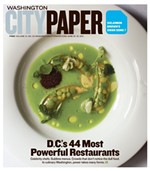In the Mode for Love
A star on the international-film-festival circuit for two decades, Taiwanese director Hou Hsiao-hsien has been hailed as one of the best—and even the best—contemporary narrative filmmakers. Yet his work has been shunned by United States distributors: Though almost all of his 17 features have been shown in Washington, this week’s opening of Three Times—at the American Film Institute, a noncommercial venue—is his first nonrepertory D.C. booking ever.
That may be because Hou’s most acclaimed films are grand period pieces about times and places little known to Americans. But what seems most difficult for those who flee Hou’s movies is simply the leisurely pacing. Regardless of what kind of story the director is telling, he’s just not a quick-cut guy. This makes even such lighter films as Three Times—a three-part meditation on love and, yes, Taiwanese history—seem forbidding. Yet the movie actually has a strong, albeit understated, sense of play, and it’s considerably breezier than Hou’s cinematic monuments. The filmmaker has elected to have some fun, even if that fun is entirely on his own austere terms.
Though Three Times (whose Chinese title is closer to “The Best of Moments”) is cool and deliberate, its narrative isn’t exactly arcane: It concerns romance through the ages—specifically, in 1966, 1911, and 2005. Hou and co-scripter Chu T’ien-wen’s scenario dovetails with previous Hou movies, functioning as an addendum to 1985’s A Time to Live, a Time to Die, a semiautobiographical coming-of-age saga; 1998’s Flowers of Shanghai, an austere, indirect tale of turn-of-the-century China set entirely in an upscale bordello; and 2001’s Millennium Mambo, an account of a freewheeling young woman that’s among the few Hou films set more or less in the present. As a further linking device, the same actors play central roles in all three episodes.
In the ’60s-set first chapter, “A Time for Love,” Chen (Chang Chen), a young man who’s about to report for compulsory military service takes refuge in a crush on a young woman who works in a local pool hall. When she disappears, he readily transfers his affections to the new girl, May (Millennium Mambo star Shu Qi). This time, the effect is lasting: When Chen comes home on leave and finds that May is gone, he conducts a search for her. Although the story’s cadence is too gentle for farce, Hou allows us to see the comic aspects of Chen’s love-struck pursuit of a woman he barely knows.
In the second round, “A Time for Freedom” (set in 1911), Shu is Ah Mei, who works in the Taiwanese equivalent of a geisha house, and Chang plays her favorite customer, Mr. Chang. A well-intentioned reformer, Chang helps one of the hostesses leave the house when she gets—as they used to say—in trouble. Ah Mei also hopes to be rescued, but Chang’s prevailing interest is opposing Japan’s rule of Taiwan. Finally, in “A Time for Youth” (2005), the liveliest yet least satisfying variation, Shu is bisexual, epileptic trip-hop poet Jing, who’s having an intense but part-time affair with Zhen, a photographer played by Chang. Both have other lovers, and Jing’s girlfriend is particularly demanding.
All three tales share motifs, including letters—in the final episode, e-mails and text messages—that express distance as much as intimacy. There’s not much dialogue, and none at all in the 1911 chapter, whose conversations are conveyed in intertitles. Hou reportedly decided on this because he despaired of accurately capturing the period’s diction, but it’s also a wry formalist prank: People in movies made in 1911 spoke in intertitles, so why not people in movies set in 1911?
The chapters are stylistically related, too, though Hou and longtime cinematographer Mark Lee Ping-bin have given each its own mode of illumination and camera movement: “A Time for Love” is keyed to natural light, which often seeps in from outside, and it uses a gliding camera placed at a medium distance from the characters (although there is one notable close-up). It may not be another of his jokes, but Hou—who paid homage to Yasujiro Ozu with his previous film, Café Lumière—borrows a few riffs from Wong Kar-wai in keying Chen’s melancholy to two recurring ballads, the Platters’ “Smoke Gets in Your Eyes” and Aphrodite’s Child’s “Rain and Tears.”
“A Time for Freedom” is lit by lamps and candles, with the camera moving a little closer to the players in the all-interior compositions—a setting emphasized by numerous shots that involve frames of various sorts. “A Time for Youth” moves quickly and eccentrically—Hou announces it by opening with a handheld shot of Zhen and Jing riding a motorcycle—and stresses neon and fluorescent light. There’s even a scene in which Jing handles a fluorescent tube while looking at photographs on the wall of Zhen’s industrial-chic apartment. Though the concerns of these tales are worldly, their interplay of light, texture, and motion constitutes an exquisitely transcendent abstract film, synchronous with the narrative.
If its theme is the role of women in Taiwanese society, Three Times represents a disheartening progression. In 1911, women are literally confined. By 1966, they have independence of movement—but only so they can be pursued by men. In 2005, women have near-absolute autonomy yet are trapped by all the possibilities. This seems glib and nostalgic—indeed, the time of Hou’s youth is portrayed most warmly—but the movie probably wasn’t intended as a postfeminist tract.
The presence of the striking Shu Qi, who deftly portrays three very different women, accentuates the female side of the film’s relationships, but Hou is more likely concerned with his perennial mistress, Taiwan itself. Three Times depicts a country that has moved from enslavement to freedom yet has misplaced something of its culture and sense of community. In its blue-tinted way, however, the film’s final anecdote is just as ravishing as the other two. Hou’s Taiwan may have lost its soul, but it hasn’t lost its beauty.

